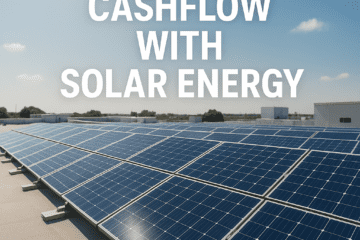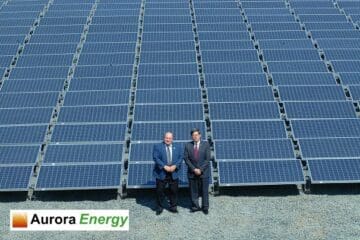How To Price a Commercial Solar System?
Pricing a commercial solar system involves multiple factors, including system size, equipment, labor, permitting, and financial incentives. Each of these elements plays a role in determining the total cost of installation.
At Aurora Energy, we specialize in helping businesses navigate the shift to solar power, offering tailored solutions that meet the unique needs of commercial properties. Whether you’re looking to improve efficiency, reduce operating costs, or enhance your company’s sustainability profile, this guide has all the information you need to make an informed decision about investing in solar energy.
Commercial System Size and Energy Usage
The first step in pricing a commercial solar system is to determine the required system size. This depends on the property’s energy consumption, typically measured in kilowatt-hours (kWh) over the past 12 months. The goal is to offset a portion or all of the property’s electricity usage with solar power.
To calculate the system size, divide the total annual energy consumption by the solar production factor, which varies based on location, shading, and system efficiency.
What are Equipment Costs of a Commercial Solar System?
The choice of solar panels, inverters, racking systems, and other hardware significantly impacts pricing. High-efficiency panels cost more but require less space, making them a preferred choice for rooftops with limited area. Panel prices typically range from $0.20 to $0.40 per watt.
Inverters are another essential component, with options including string inverters, microinverters, and power optimizers. String inverters are commonly used in large commercial applications, but other options are also available. There are also microinverters and inverters combined with optimizers that may cost slightly more but provide module-level power optimization.
The mounting structure also affects pricing, with ballasted rooftop systems being cost-effective, whereas fixed-tilt or ground-mounted arrays require more materials and installation aspects.
What are the Installation and Labor Costs
Labor costs include site preparation, electrical work, racking installation, and module mounting. These costs vary by location and project complexity. If a project requires roof reinforcements or trenching for underground wiring in a ground-mounted system, these additional construction expenses can add to the overall cost.
What is Soft Cost’s Percentage of a Commercial Solar
Soft costs include all non-hardware expenses and can make up 30-50% of the total system price. These include permitting, interconnection, engineering, insurance, landscaping, and project management.
Permitting and Inspections: Local governments require permits for electrical and structural aspects of solar installations. The costs can range from a few thousand dollars for smaller systems to $50,000 or more for large commercial projects with strict regulatory requirements. Permit fees cover plan review, structural analysis, and electrical inspections.
Interconnection Fees: Some Utilities charge fees for grid connection approvals, which vary depending on system size and local regulations. Some projects require transformer upgrades or relay protection studies, adding significant expenses. These costs can range from a few thousand dollars to over $100,000 for larger systems.
Engineering and Design: Every commercial solar project requires detailed electrical and structural design work, including stamped drawings from licensed engineers.
Insurance and Warranties: Property owners often require insurance coverage for the commercial solar system, including general liability and business interruption coverage. Many developers also provide performance guarantees and extended warranties. Comprehensive warranties on panels (typically 25 years), inverters (10-15 years), and workmanship (varies) may add an additional 5-10% to the total system cost.
Project Management and Legal Fees: Large-scale commercial solar installations require project management to oversee timelines, coordinate subcontractors, and ensure compliance with contracts and regulations. Legal fees may also be necessary to draft power purchase agreements (PPAs) or leasing contracts.
Financial Incentives and Cost Reduction
Several financial incentives help reduce the upfront cost of commercial solar systems. The federal Investment Tax Credit (ITC) currently allows businesses to deduct 30% of installation costs. Additional benefits come from the Modified Accelerated Cost Recovery System (MACRS), which provides accelerated depreciation, significantly reducing tax liabilities.
Some states and local governments offer rebates, grants, or property tax exemptions. In regions with Solar Renewable Energy Credit (SREC) markets, businesses can earn revenue by selling SRECs to utilities, providing an additional return on investment.
Final Cost and Payback Considerations of a Commercial Solar Investment
After factoring in equipment, labor, soft costs, and incentives, the total cost of a commercial solar system typically falls between $1.50 and $3.00 per watt for rooftop systems and can be greater for carport and canopy installations.
To determine the return on investment, businesses must calculate their expected energy savings.



